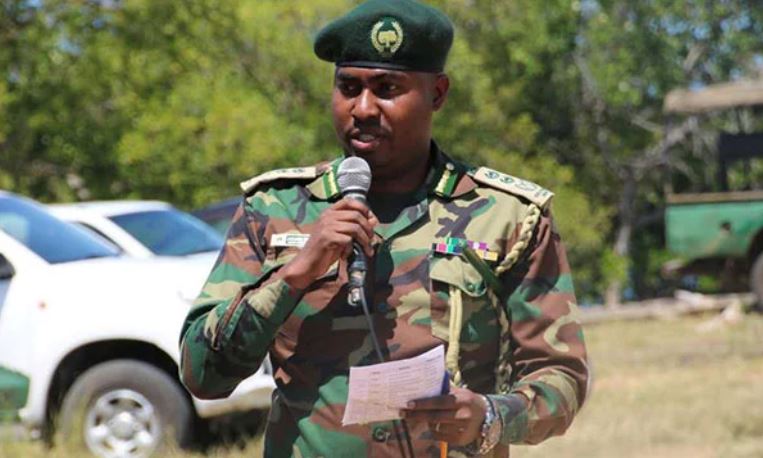 Chief Conservator of Forests Julius Kamau responds to questions from the public via Sunday Nation.
Chief Conservator of Forests Julius Kamau responds to questions from the public via Sunday Nation.
1. The decision of the national government to ban logging all over Kenya adversely affected the timber industry and saw the closure of timber factories, sawmills and loss of jobs for hundreds of people who either directly or indirectly depended on this sector. What do you have to say, taking into consideration that this was a legal venture with huge economic benefits to our country?
Dan Murugu, Nakuru
The moratorium on logging was a government decision that is in force to date. I do agree that the commercial plantations managed by KFS supplied roundwood to the forest industry, which is key to socio-economic development of the country.
It is also important to appreciate that one of the recommendations of the Task Force Report, 2018 on logging activities in Kenya was to have a paradigm shift in the way in which the forest materials are disposed of to deter loss of public revenue.
In implementing this recommendation, KFS has, during the moratorium period, been reforming and strengthening its administrative and governance systems such as the development of standard operating procedures, systems integration and e-registration platform for saw millers to provide an efficient, transparent and accountable forest material disposal process in readiness to as and when the government lifts the moratorium.
Currently, most of the forest industries source wood from farmlands, and as such supporting livelihoods of thousands of farmers. While appreciating that the KFS commercial plantations of about 135,000 hectares cannot meet the country’s wood demand, and in order to complement this supply, it is important that saw millers consider investing in out-grower schemes with farmers around their geographical location to complement wood supply from the public forests. This is the only way the sustainability of the forest industry in Kenya can be guaranteed.
2. In the wake of the Covid-19 pandemic, little has been heard about the reclamation of the Maasai Mau Forest, which was just taking shape. Sir, what is the status of this all-important operation which aimed at restoring a crucial water tower? What challenges have you encountered as a result of the Covid-19 pandemic in so far as restoration of the water tower is concerned?
Moris Komen, Eldoret
Yes, much could not have been heard, but much is being done. It is a conservation fact that reclamation is noisy while restoration is silent. In this silence, and since November 1, 2019, when restoration was launched by the Cabinet Secretary for Environment and Forestry Keriako Tobiko, more than a million tree seedlings have been planted, and this has not been KFS alone but with other agencies including the Ministry of Environment, Kenya Water Towers Agency (KWTA), National Environment Management Agency (NEMA), Ewaso Nyiro South Development Authority (ENSDA), Kenya Forestry Research Institute (KEFRI) and Toyota Kenya, among others.
Indeed, the restoration activities of land preparation, planting and maintenance is being done by the community members who were affected by the reclamation and this has been a major source of livelihood for them at this critical time of the coronavirus pandemic. KFS is in the process of establishing a community forest association to participate in the restoration and management of the forest in line with the Forest Conservation and Management Act (FCMA), 2016.
One of the challenges we have encountered is a positive one, the fact that forest rangers have ensured that there is no reinvasion nor grazing. There is intense undergrowth which means increased cost of maintenance to ensure optimal survival. We are also calling upon other partners to join us in the restoration process.
3. There are communities who have lived in forests since time immemorial but the threat to nature and the need to conserve forests conflicts with their desire to keep their homes and ancestral land. How do you balance between livelihoods and cultures of these people and conservation of these forests for the future?
Shem Onderi, Kisii
The FCMA, 2016 provides a clear legal framework that ensures balance between forest conservation and community livelihoods and culture, though very delicate. On one hand, the law does not allow any individual or a community to reside inside a public forest.
On the other hand, it requires that a Community Forest Association (CFA) be formed in every forest station and to participate in forest management through a participatory forest management plan and forest a management agreement between KFS and the CFA.
This participatory management regime ensures that the forest adjacent community has specific user rights to forest resources.
4. There are very many sawmillers who had paid for materials before the ban on logging came into effect. At the time, some of the timber had been cut but is now being stolen or rotting out in the field because of the ban. Do you have plans to compensate these millers or would you allow them to collect the timber that had been cut and paid for?
John Wakaba, National Secretary, Timber Manufacturers Association
KFS urges that any sawmiller whose transactions were not concluded at the time the moratorium came into force needs to present their documentary evidence to the respective forest station. The service will then verify each claim on a case-by-case basis.
5. Blatant destruction of forests through logging undermines Kenya’s push to realise 10 per cent forest cover as recommended by the United Nations. What measures have you taken to tackle the menace?
Raphael Obonyo, Nairobi
Based on our forest crime trend analysis, cases of forest destruction have significantly reduced.
Notably, though, is that, during the Covid-19, KFS has witnessed increased pressure of forest resources but the enforcement unit has firmly been able to detect and deter such attempts. Thanks to members of the public for complementing our efforts by conveying critical information on forest illegalities.
This is as a result of various measures and interventions that KFS has instituted including enhanced patrol and surveillance of forests by the forest rangers, enhanced community forest association participation in the management of forest resources, multi-agency security operations and the use of technology such as Forest 2020 App used for registering forest crimes.
6. There are concerns that Kenya Forest Service management has failed to protect the country’s forest from wanton destruction. Corruption among forest officers has been identified as a leading cause of forest destruction. What strategies have you put in place to streamline the agency?
Raphael Obonyo, Nairobi
Addressing corruption highly depends on the leadership of any organisation. As such, with the support of the ministry and the board, I have instituted a leadership of integrity, a leadership that has ensured that every forest officer is responsible in his/her area of jurisdiction but equally held personally accountable for any act of commission or omission in collusion or aiding acts of forests destruction.
With a staff level of more than 4,300, it is possible to encounter a few cases of collusion, but KFS has put in firm measures to detect and deter such cases in real time. KFS also works closely with other government agencies in the fight against corruption.
Further, KFS appreciates that forest protection is a collective responsibility for all Kenyans and in line with this, KFS has enhanced its partnership and relationship with the forest adjacent communities with an aim of turning them into our allies in forest protection.
7. Sir, with regards to the plan to increase Kenya’s forest coverage to the globally recommended 10 per cent, where are we currently? Could you make an assessment on the issue in terms of the percentage achieved so far?
Francis Njuguna, Kibichoi
Kenya’s forest cover stands at 7.2 per cent of the country’s land area. The Service is implementing a strategy to achieve 10 percent tree cover by 2022 which is being coordinated by the ministry of Environment and Forestry in collaboration with other ministries, departments and agencies of government, county governments, private sector, non-state actors, learning institutions, communities and the public.
Public forest accounts for four per cent of the forest cover and, therefore, if the country is to attain 10 per cent tree cover, there is need to promote tree planting on available land in various government institutions like schools and farmlands. Indeed, I wish to urge all Kenyans to comply with the Farm Forestry Rules 2009, which require that all land owners are required to plant trees on 10 per cent of their land.
If all Kenyans did this then, we would surpass the 10 per cent target. I am therefore urging all Kenyans to take advantage of the current rains to plant trees in their farms while observing government directive on Covid- 19.
8. I am a son of one of the victims of land injustice who were victimised and denied land allocation in the 1959 demarcation. Currently, I am a squatter living in a slum in Kikuyu constituency, just 500 metres from Thogoto/Ngong forest. Is it true that there are some 200 acres of land to be carved out of the forest to settle these genuine squatters? If not, what do these squatters who have been made to believe there is land somewhere meant for them do?
Samuel Ngigi, Kikuyu
Thogoto/Ngong Road forest are gazetted public forests and therefore there is no land for settlement. All matters of settlement and/or resettlement are under the jurisdiction of the ministry of Lands and the National Land Commission.
However, I encourage you to join the Community Forest Association so that you can effectively participate in the management of the forests.
9. I am mobilising young girls and women in Kandara sub-county, Murang’a County, to plant trees in the water towers. What permits do we need? What procedures do we need to follow?
Njeri Muathe, Murang’a County
Thank you. Recently, KFS and the ministry of Environment formulated ‘adopt a forest framework’. The intention of the framework is to ensure that our partners’ initiatives of growing trees in our forest like yourselves are sustainable and not one off planting without follow-up and maintenance like it has been the case before.
Therefore, all you need to do is register your interest with the Service and the Service will consider your request and allocate a specific area in the forest for planting and maintenance for not less than three years. So far, we are encouraged by the very many partners who have engaged with us through this modality and we encourage others to do the same.
10. Since the moratorium on logging was issued in 2018 (and subsequent extensions thereafter), has an audit been done to see if indeed it is helping to meet the intended objective — to increase forest cover from seven to 15 per cent by 2022?
Howard Akimala, Njoro
Forest cover assessment is a very elaborate and scientific process and currently there is an ongoing national forest cover assessment.
11. Community Forest Associations (CFAs) complement KFS’ efforts in forest conservation but only benefit marginally. Would it not be prudent for such CFAs to get a percentage of income accrued from such forests as opposed to being limited to collecting firewood and hanging beehives?
Howard Akimala, Njoro
Participatory forest management between KFS and the Community Forest Associations is provided for in the Forest Conservation and Management Act, 2016 and is executed through Participatory Forest Management Plans and Forest Management Agreement which is a negotiated process between KFS and the CFA. The Plan clearly identifies the Community User Rights and Responsibilities. The User Rights are prescribed in the FCMA 2016 and includes income generating activities such as apiary, eco-tourism, recreational activities, and contractual labour to carry out specified forestry operations including PELIS which greatly support the livelihoods of the forest adjacent communities.
12. What measures are you implementing to modernise and professionalise the Service to respond to the challenges of our time facing the environment, including climate change?
James Gichuki
KFS has a Climate Change Unit whose work is to integrate climate change aspect in all its programmes and support the Service in implementing the national, regional and international Climate Change obligations relating to the forest sector.
In the new organisational structure, which is at an advanced stage this unit has further been strengthened to adequately respond to the increasing relevant climate discourse in the forest sector.
In addition, our Kenya Forest College Londiani has revised its curriculum to include aspects of Climate Change to ensure that its certificate, diploma and in-house graduates are well prepared to tackle Climate Change and forest discourse.
13. Forests in Kenya play a pivotal role both in human and animal lives. However, they are under threat from illegal logging. What mechanisms have you put in place to stop the illegal logging?
Bernard Chetambe Lipesa, Nairobi
Kenya Forest Service is responsible for approximately 2.59 million hectares of gazetted forests across the country and further provides technical and capacity building support to the County Governments in protection of community forests and promoting farm forestry. Our forest officers and rangers continue to conserve, manage and protect these forest resources from various pressures including illegal logging, over grazing, encroachment and forest fires.
KFS officers and rangers are at the forefront protecting these resources and sometime putting their lives on the line to protect them for the common good of all Kenyans. I wish to thank them for this! It is therefore, important to appreciate that even though KFS is the lead agency, we will never have enough rangers to guard every tree and therefore we have developed forest information systems and technology application such as Forest 2020 App to help in monitoring, detecting and responding to forest crime incidences.
Indeed KFS has been piloting the use of drones in forest surveillance to complement our air wing capabilities. In addition, KFS continues to deepen its collaboration with other national security agencies, county governments and forest adjacent communities to ensure that forests are protected.
14. Sir, is there a programme to involve schools especially primary and secondary schools in planting of trees in the many empty spaces available?
Samuel Maina
Yes, under the national tree cover strategy schools are part of the planting programmes to date, hundreds of learning institutions have participated in tree growing and plans are underway to intensify the participation of school children and youth, through collaboration with the Ministry of Education and County Governments.
We also encourage schools to take their own initiative in developing tree nurseries in their compound and putting their 10 per cent land area under trees that speak to their needs such as shade and fruit trees.






